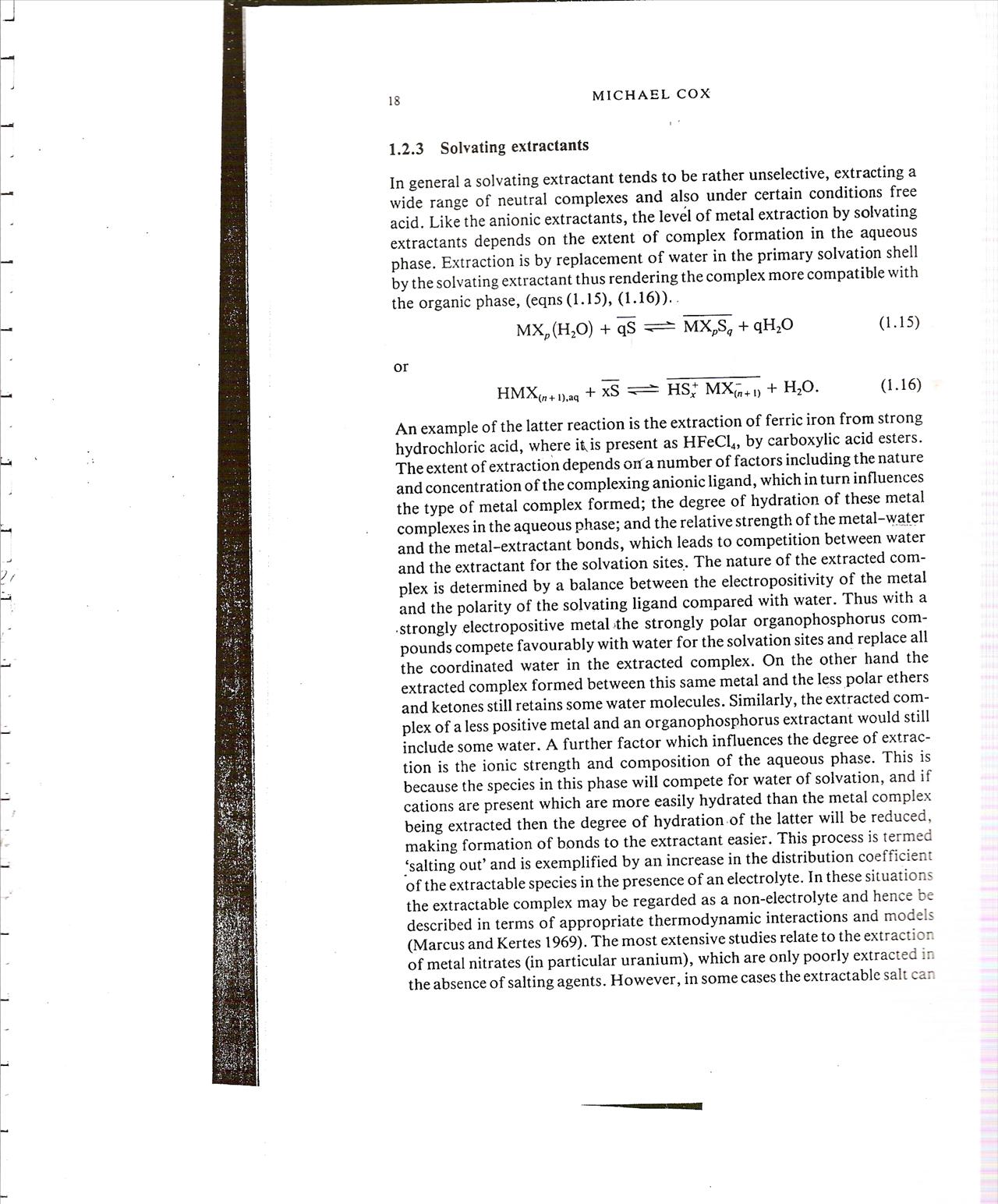scan0031 4

18 MICHAEL COX
1.2.3 Solvating extractants
In generał a soWating extractant tends to be rather unselective, extracting a wide rangę of neutral complexes and also under certain conditions free acid. Like the anionie extractants, the level of metal extraction by solvating extractants depends on the extent of complex formation in the aqueous phase. Extraction is by replacement of water in the primary solvation shell by the soWating extractant thus rendering the complex morę compatible with the organie phase, (eqns(1.15), (1.16))..
MXp(H20) + qS MXpS<7 + qH20 (1.15)
or
HMX(„+1,aq + ^ HS; MX(;+I) + H20. (1.16)
An example of the latter reaction is the extraction of ferric iron from strong hydrochloric acid, where iiis present as HFeCl4, by carboxylic acid esters. The extent of extraction depends on a number of factors including the naturę and concentration of the complexing anionie ligand, which in turn influences the type of metal complex formed; the degree of hydration of these metal complexes in the aqueous phase; and the relative strength of the metal-water and the metal-extractant bonds, which leads to competition between water and the extractant for the soWation sit es. The naturę of the extracted com-plex is determined by a balance between the electropositivity of the metal and the polarity of the soWating ligand compared with water. Thus with a •strongly electropositWe metal the strongly polar organophosphorus com-pounds compete favourably with water for the soWation sites and replace all the coordinated water in the extracted complex. On the other hand the extracted complex formed between this same metal and the less polar ethers and ketones still retains some water molecules. Similarly, the extracted com-plex of a less positWe metal and an organophosphorus extractant would still include some water. A further factor which influences the degree of extrac-tion is the ionic strength and composition of the aqueous phase. This is because the species in this phase will compete for water of soWation, and if cations are present which are morę easily hydrated than the metal complex being extracted then the degree of hydration of the latter will be reduced, making formation of bonds to the extractant easier. This process is termed ‘salting out’ and is exemplified by an inerease in the distribution coefficient of the extractable species in the presence of an electrolyte. In these situations the extractable complex may be regarded as a non-electrolyte and hence be described in terms of appropriate thermodynamic interactions and models (Marcus and Kertes 1969). The most extensive studies relate to the extractior of metal nitrates (in particular uranium), which are only poorly extracted ir. the absence of salting agents. However, in some cases the extractable salt car
Wyszukiwarka
Podobne podstrony:
scan0035 2 MICHAEL COX metal-extractant bonds are strongj morę specific reagents are required. As th
scan0023 3 10 MICHAEL COX have an appreciable aqueous solubility, which can, under operating condi-t
scan0027 3 14 MICHAEL COX (p - n) R4N* Y" + MXjT«- ^ (R4N)p.łł(MXp) + (p-n)Y * (1.12) An altern
scan0039 2 26 MICHAEL COX di-2-ethylhexylphosphoric acid. The presence of a third phase causes con-s
scan0041 2 28 MICHAEL COX For use as a diluent a liąuid should satisfy the following criteria: a wid
scan0043 2 30 MICHAEL COX hydrodynamic parameters but are difficult to set up and operate. Trouve et
BSc IN ENVIRONMENTALPROTECTION AND MANAGEMENT Degree to be obtained Bathelor of Science Duration
summaries the third should be in Spanish. If it were to be held in Russia it would obviously be in R
Polo Collars Enlargod view of the increases. In order for the collar to be fuli cnough, you have to
Move-To change in position from one point to another Raise-increase in pay, grow, increase Dese
Sulekha’s use of the masculine in the above examples seems to be influenced by a local understanding
cbook04 (iv)RECYPHERING OBLIGATORY. MmagM in thi* Cypher are mvariahly to be recyphered before deapa
UNIVERSITY OF MADRASM.Sc. DEGREE COURSE IN INFORMATION TECHNOLOGY REVISED REGULATIONS (To be offered
95 (2) Add file to project □ Do you want to add this new file in the active project (has to be saved
więcej podobnych podstron